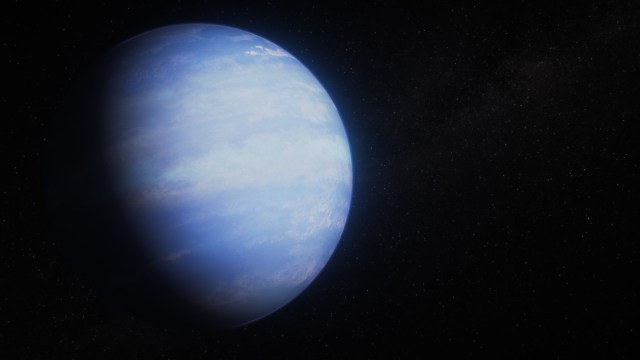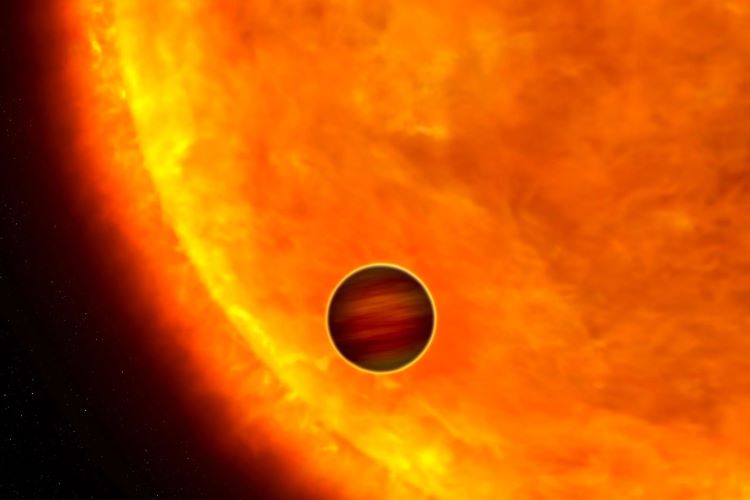Ever since the advent of space exploration we have seen some amazing images of the planets. New technology often brings with it a new perspective and we have been reminded of this again just recently with images from the Hubble Space Telescope (HST) and New Horizons spacecraft. The two objects simultaneously imaged Uranus from different perspectives in an attempt to predict what astronomers would see when they look at exoplanets orbiting other stars.
Continue reading “Hubble and New Horizons Look at Uranus at the Same Time”A New Way to Detect Rocky Exoplanet Atmospheres

The total number of exoplanets discovered to date totals 5,288. Among them are a host of rocky, Earth-like exoplanets but none of them seem to have atmospheres. It’s a fairly challenging observation to make but a team of researchers think they’ve come up with a new, simpler technique. It involves measuring the combined temperature of a star and the exoplanet just before the planet passes behind. If it’s lower than expected, the planet is likely to have an atmosphere regulating its temperature!
Continue reading “A New Way to Detect Rocky Exoplanet Atmospheres”Astronomers Find a Strange Lopsided Planet

I’ve often stated that planets come in a wide range of sizes but rarely do I find myself stating they come in a wide range of shapes too! The discovery of WASP-107b is a case in point since this planet is the size of Jupiter but only a tenth of its mass. But there’s more… Using the James Webb Space Telescope a team of astronomers have accurately identified that the planet has an east-west asymmetry in its atmosphere, in other words, it’s lopsided. It is tidally locked to the star and on one side, the atmosphere seems to be inflated compared to the other.
Continue reading “Astronomers Find a Strange Lopsided Planet”Iron Winds are Blowing on WASP-76 b

Exoplanets have been discovered with a wide range of environmental conditions. WASP-76b is one of the most extreme with a dayside temperature of over 2,000 degrees. A team of researchers have found that it’s even more bizarre than first thought! It’s tidally locked to its host star so intense winds encircle the planet. They contain high quantities of iron atoms that stream from the lower to upper layers around the atmosphere.
Continue reading “Iron Winds are Blowing on WASP-76 b”X-Ray Telescopes Could Study Exoplanets Too
Exoplanets are often discovered using the transit method (over three quarters of those discovered have been found this way.) The same transit technique can be used to study them, often revealing detail about their atmosphere. The observations are typically made in visible light or infrared but a new paper suggests X-rays may be useful too. Stellar wind interactions with the planet’s atmosphere for example would lead to X-ray emissions revealing information about the atmosphere. As we further our exploration of exoplanets we develop our understanding of our own Solar System and ultimately, the origins of life in the Universe.
Continue reading “X-Ray Telescopes Could Study Exoplanets Too”Why is JWST Having So Much Trouble with the TRAPPIST-1 System?

When the James Webb Space Telescope was launched it came with a fanfare expecting amazing things, much like the Hubble Space Telescope. One of JWST’s most anticipated target was TRAPPIST-1. This inconspicuous star is host to seven Earth-sized planets, with at least three in the habitable zone. The two inner planets are airless worlds but so far there has been no word of the third planet, the first in the habitable zone. The question is why and what makes it so tricky to observe?
Continue reading “Why is JWST Having So Much Trouble with the TRAPPIST-1 System?”What Impact Does Ozone Have on an Exoplanet?
As we discover more and more exoplanets – and the current total is in excess of 5,200 – we continue to try to learn more about them. Astrobiologists busy themselves analysing their atmospheres searching for anything that provides a sign of life. It is quite conceivable of course that the Universe is teeming with life based on very different chemistry to ours but we often look to life on Earth to know what to look for. On Earth for example, ozone forms through photolysis of molecular oxygen and is an indicator of life. Using the James Webb Space Telescope astronomers are searching stars in the habitable zone of their star for the presence of ozone and how it impacts their climate.
Continue reading “What Impact Does Ozone Have on an Exoplanet?”Webb Explains a Puffy Planet
I love the concept of a ‘puffy’ planet! The exoplanets discovered that fall into this category are typically the same size of Jupiter but 1/10th the mass! They tend to orbit their host star at close in orbits and are hot but one has been found that is different from the normal. This Neptune-mass exoplanet has been thought to be cooler but still have a lower density. The James Webb Space Telescope (JWST) has recently discovered that tidal energy from its elliptical orbit keeps its interior churning and puffs it out.
Continue reading “Webb Explains a Puffy Planet”Maybe Ultra-Hot Jupiters Aren’t So Doomed After All
Ultra-hot Jupiters (UHJs) are some of the most fascinating astronomical objects in the cosmos, classified as having orbital periods of less than approximately 3 days with dayside temperatures exceeding 1,930 degrees Celsius (3,500 degrees Fahrenheit), as most are tidally locked with their parent stars. But will these extremely close orbits result in orbital decay for UHJs eventually doom them to being swallowed by their star, or can some orbit for the long term without worry? This is what a recent study accepted to the Planetary Science Journal hopes to address as a team of international researchers investigated potential orbital decays for several UHJs, which holds the potential to not only help astronomers better understand UHJs but also the formation and evolution of exoplanets, overall.
Continue reading “Maybe Ultra-Hot Jupiters Aren’t So Doomed After All”Saturn-Sized Exoplanet Isn’t Losing Mass Quickly Enough
We have discovered over 5,000 planets around other star systems. Amongst the veritable cosmic menagerie of exoplanets, it seems there is a real shortage of Neptune-sized planets close to their star. A new paper just published discusses a Saturn-sized planet close to its host star which should be experiencing mass loss, but isn’t. Studying this world offers a new insight into exoplanet formation across the Universe.
Continue reading “Saturn-Sized Exoplanet Isn’t Losing Mass Quickly Enough”





